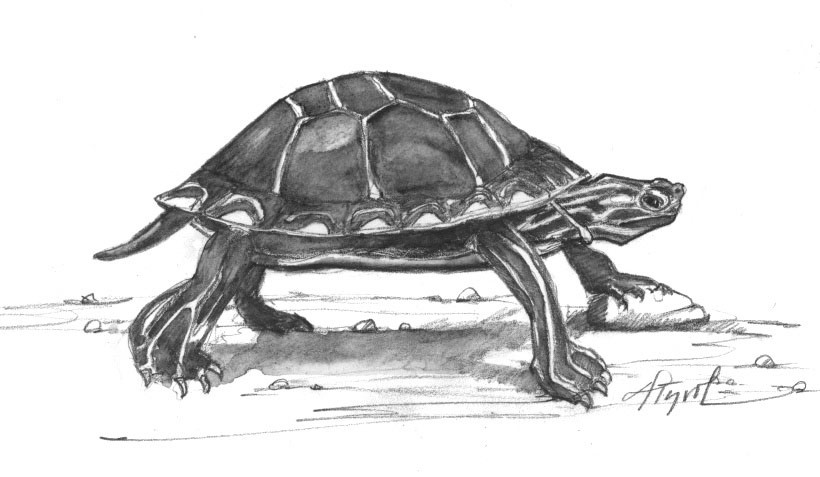
The turtle was lying on the white line marking the road edge as I pulled my car over to move it. It was a small painted turtle, and its shell had a deep crack across it. She was taking her last breaths.
I suspected that this was a female before I even got a good look at her, but a close look at her tail confirmed my suspicion. Most turtles wandering away from water at this time of year are females searching for a good place to lay eggs. Many cross roadways and never make it to a nesting site.
I wondered if these accidents were having a detrimental effect on turtle populations, so I contacted Dr. James Gibbs from State University of New York College of Environmental Science and Forestry, who has been studying the problem of adult turtle mortality and its effects on turtle populations overall.
“Most turtle species cannot tolerate much adult mortality, but we had no idea how many turtles were crossing roads and whether road mortality represented a serious threat or not,” said Gibbs. “So we modeled turtle movements in a computer as a first attempt to frame the problem, and it indicated that road mortality could indeed be a problem.” The model, published in the journal Conservation Biology, predicted that road networks typical of the Northeast have the potential to limit turtle populations.
“A breeding adult female turtle is a very valuable component of a local population,” noted Dr. Greg Shriver, a former student of Gibbs’s who now works at the Marsh-Billings-Rockefeller National Historical Park in Woodstock, Vermont. Adult turtles live long lives and have delayed sexual maturity. Contrast turtles with rabbits, for example, to get an idea of a species that reproduces early and often and for whom, therefore, the survival of each individual adult female is less crucial.
Road networks, meanwhile, are becoming busier and larger. Recently, the Vermont Fish and Wildlife Department’s (VFWD) Nongame and Natural Heritage Program newsletter, Harmonies, reported that during the past 10 years, Vermont’s population has grown 8.2 percent while at the same time the number of registered vehicles has increased 24 percent. Vermont has over 14,000 miles of roads, and the Vermont Agency of Transportation (VTrans) estimates that the number of vehicle miles traveled by Vermonters is growing seven times faster than the population.
Has that kind of growth in Vermont, let alone other regions of the Northeast, affected turtle populations over the years? “Unfortunately, yes,” says Gibbs. “The real issue is that roads are getting more impenetrable every year to animals trying to cross them.” The more cars there are on the roads, the more likely a collision becomes.
In a separate study, Gibbs and his student David Steen found that the proportion of males in turtle populations has increased linearly with the expansion of road networks and traffic use. States and regions with higher road densities and more people have fewer female turtles.
Gibbs and Steen teamed up to gather field evidence by examining painted turtle and snapping turtle populations in wetlands with low road densities and others with high road densities. As predicted, both species had male-biased sex ratios in wetlands adjacent to high road densities. Females like the one I found are likely being killed on roadways during annual nesting migrations – a harrowing journey that male turtles do not make.
While this problem may not be as severe in the rural corners of Vermont and New Hampshire as it is in more densely populated areas, it could still threaten some populations. “Even though this region has [a] lower road density on the landscape than other places, the traffic volume is high enough to still cause mortality that could result in turtle population declines. I am always surprised to see road kill on dirt roads while mountain biking in Vermont, indicating that it does not take too many vehicles passing by to cause mortality,” notes Shriver.
In an effort to address these fatal encounters, an interagency wildlife-crossing team was recently established by VTrans, consisting of trained VTrans employees and several VFWD biologists, to identify areas of high mortality. The team is creating a statewide map and database for wildlife crossings, habitat, road mortality, and transportation information. It will be used to identify significant wildlife corridors associated with state and town roads and assist in future planning.
“When roads are reengineered, crossing barriers or tunnels, as appropriate, can be installed. This is where mitigation is headed, and it’s in a very positive direction,” said Gibbs.
“Avoiding road crossings, or actually stopping turtles from moving across the road, can really make a difference,” said Shriver. It was too late for the turtle I found, but the future might be a little brighter for others.

